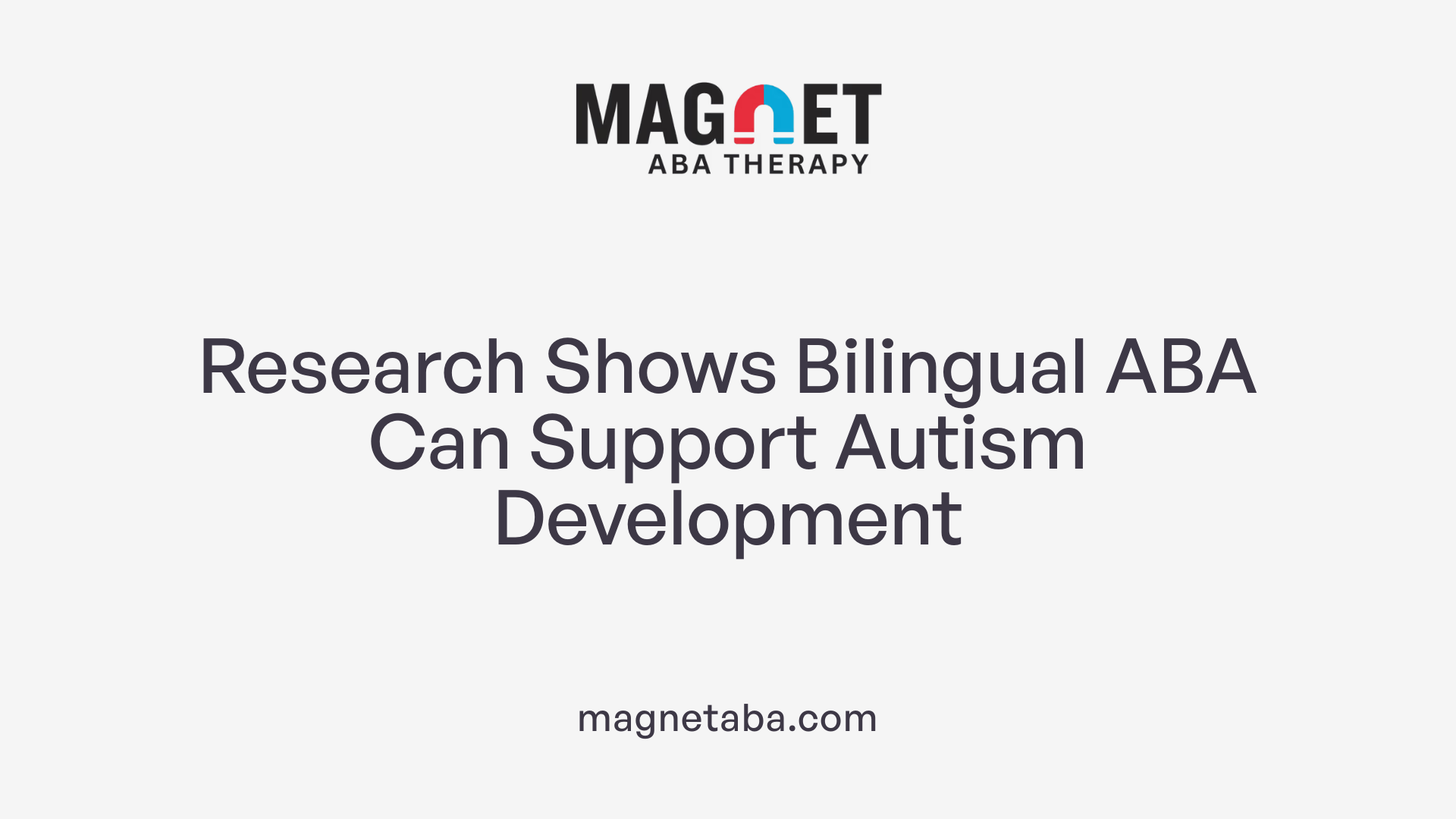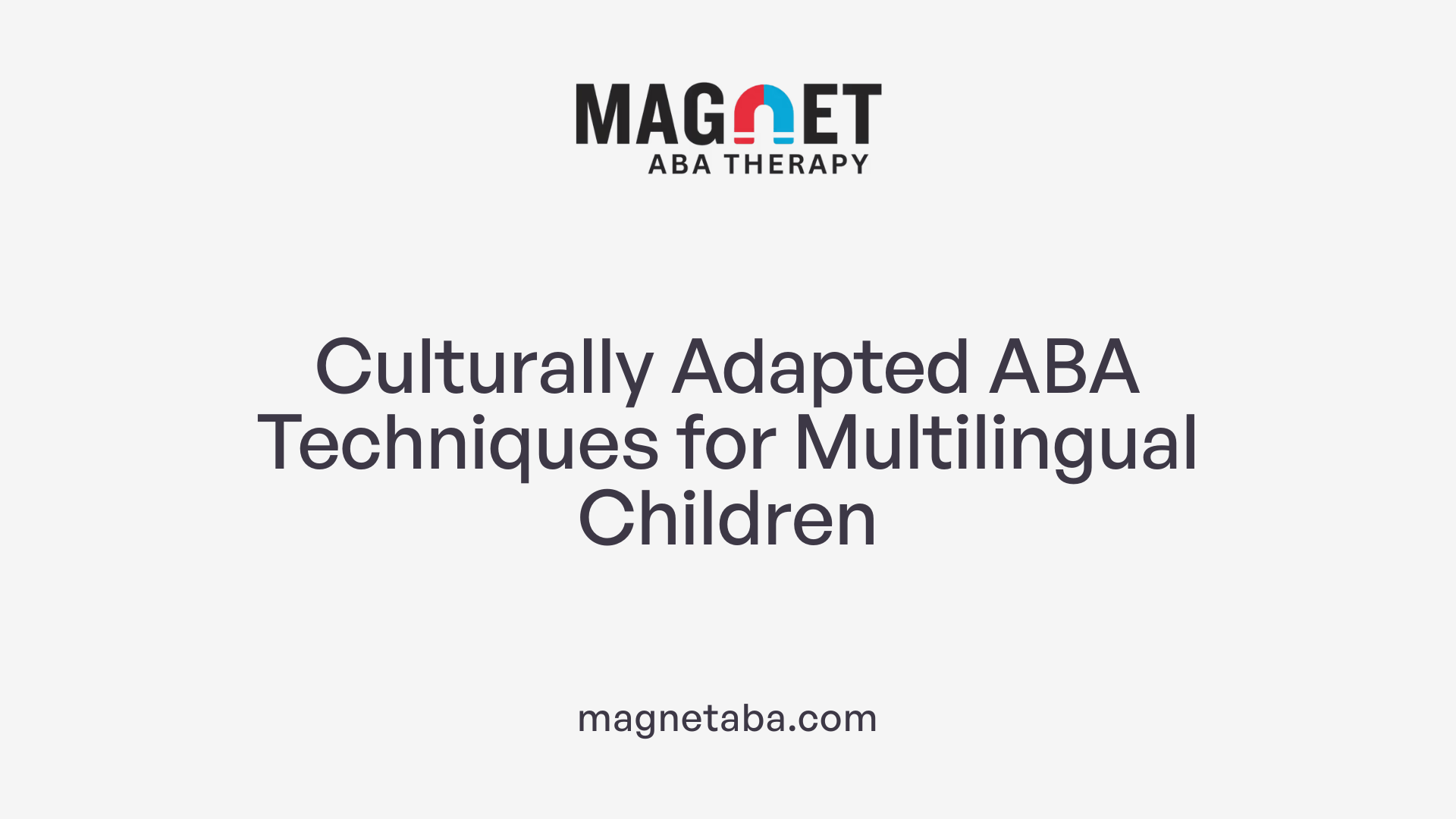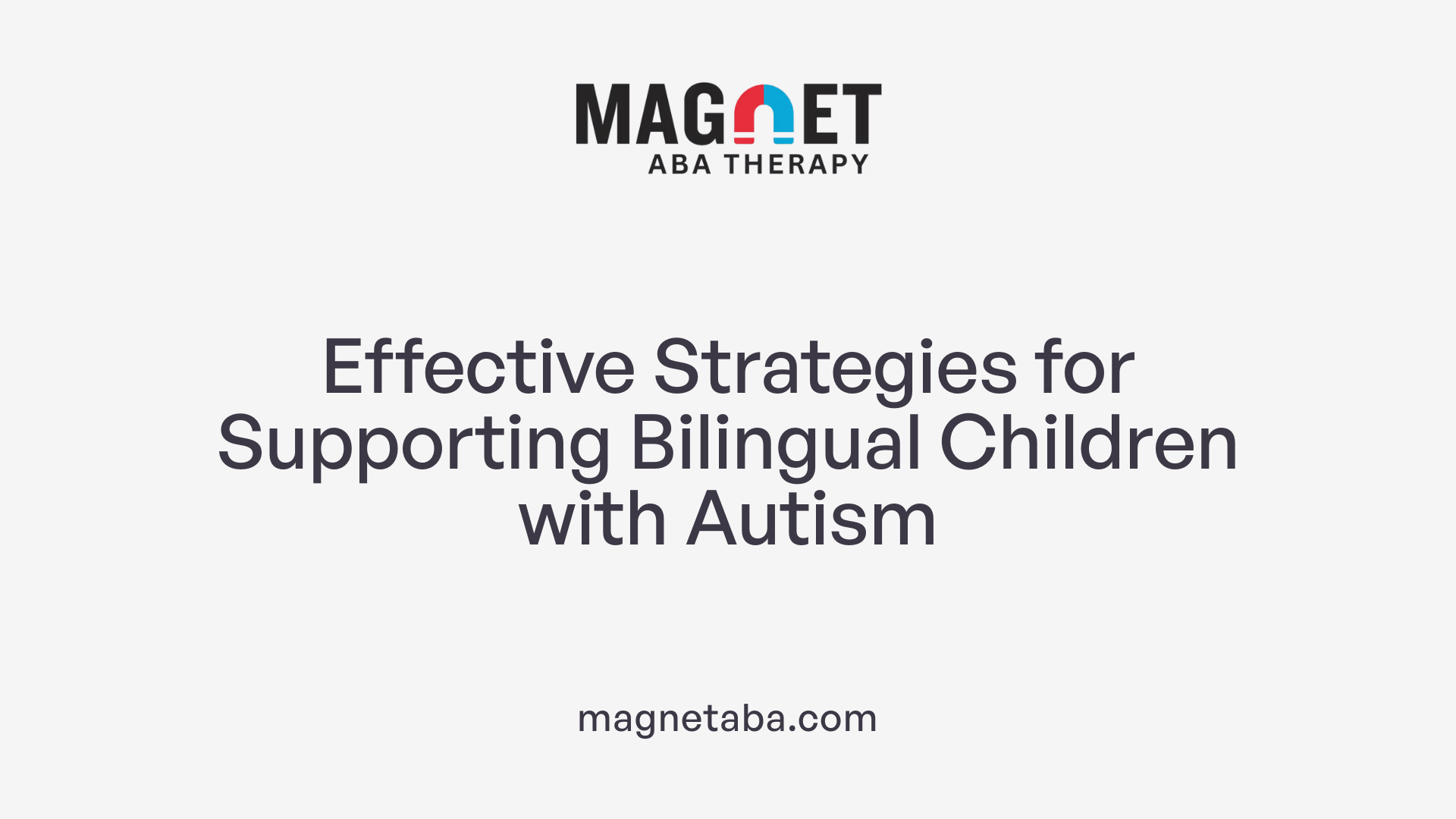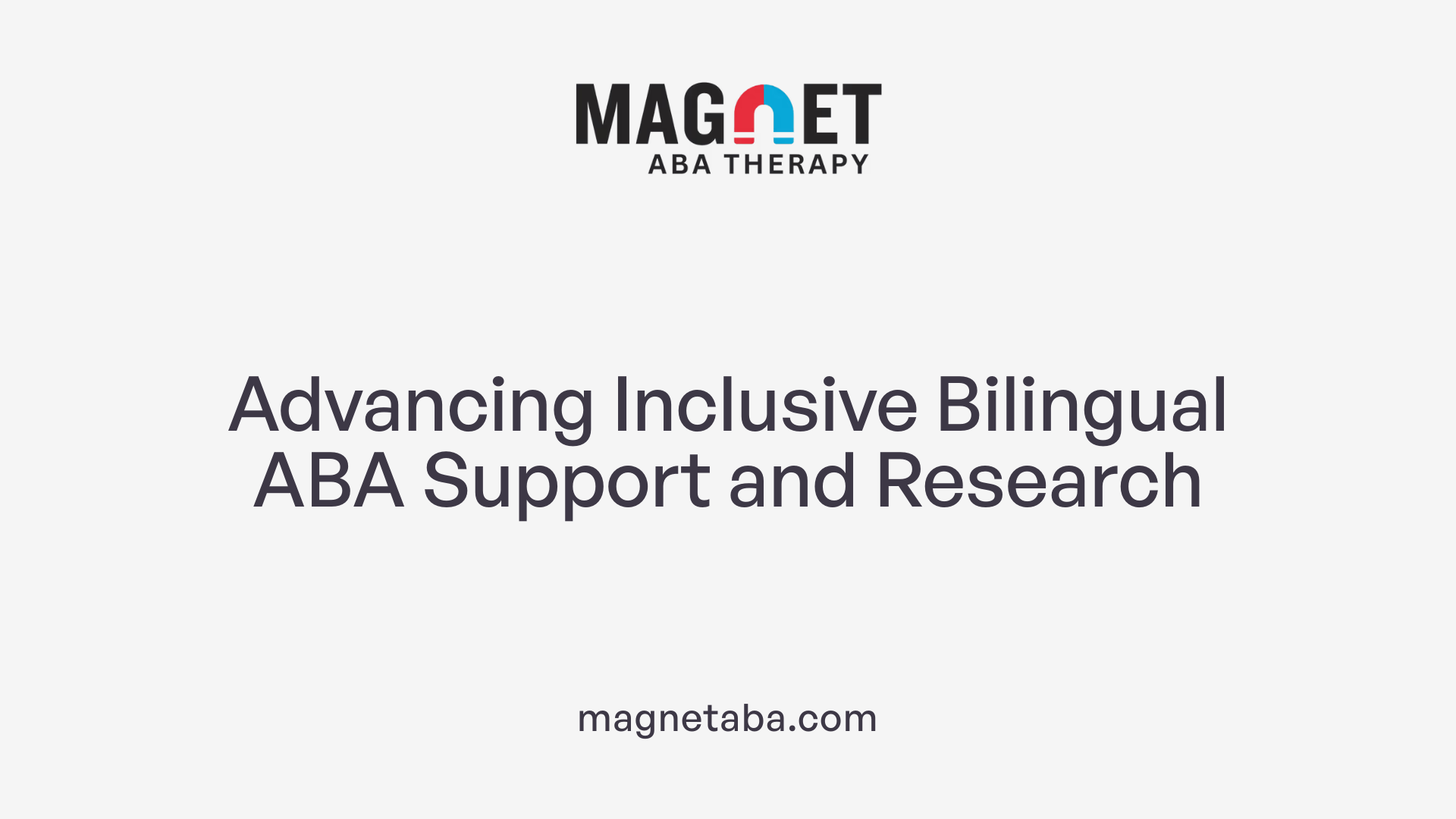Understanding the Intersection of ABA and Multilingual Environments
As linguistic diversity grows in the context of autism intervention, understanding how Applied Behavior Analysis (ABA) can effectively support bilingual and multilingual children becomes increasingly important. This article explores current research, best practices, and practical considerations to optimize ABA services for children navigating multiple languages, ensuring they receive culturally sensitive and effective support.
Research Evidence on ABA Effectiveness for Multilingual Children with Autism

What does research say about the effectiveness of ABA for bilingual or multilingual children with autism?
Research demonstrates that ABA therapy is a suitable and effective approach for supporting language and communication development in bilingual children with autism. Studies indicate that bilingualism does not hinder the progress of children with ASD; in fact, their developmental outcomes are often comparable to those of monolingual peers.
Multiple research efforts reveal that bilingual children with autism can develop language skills in both their primary and secondary languages. Bilingual instruction methods—whether simultaneous, where both languages are introduced at the same time, or sequential, where a second language is added later—are effective in enhancing vocabulary and communication skills. Notably, children engaged in simultaneous bilingual learning often show superior performance in areas such as listener responses and intraverbals.
Furthermore, children raised in bilingual settings tend to have some social benefits, including improved gesture use and larger vocabularies. These advantages may be linked to the cognitive flexibility involved in managing multiple languages. Overall, evidence suggests that supporting bilingual development in autism can not only facilitate effective communication but also encourage broader social and cognitive growth.
It is important to note, however, that some challenges exist, such as managing multiple languages and ensuring access to culturally and linguistically appropriate interventions. Nonetheless, the current understanding affirms that the advantages of bilingualism roughly outweigh the risks, and including bilingual strategies within ABA programs can be highly beneficial.
Adapting ABA Interventions for Bilingual and Multicultural Contexts

How can ABA be adapted to support bilingual or multilingual children, including best practices and considerations?
Adapting ABA interventions for children who grow up multilingual involves integrating their native languages within therapy approaches. This supports not only language development but also cultural identity. Using culturally relevant visual aids, storybooks, and modeling correct language use in both languages helps create a supportive environment.
Engaging family members and caregivers who speak the child's home language is crucial. Their involvement ensures consistent communication across settings and fosters cultural competence for the therapist. Incorporating the family’s linguistic preferences and norms promotes more meaningful and effective interactions.
Assessment practices should be conducted in the child's primary or dominant languages whenever possible. This allows clinicians to accurately evaluate strengths and needs without language barriers skewing the results. When assessments in the native language are unavailable, qualified translation services can be used to ensure precise understanding.
Supporting bilingualism in children with autism does not mean choosing one language over another; instead, it involves promoting language maintenance while developing functional communication skills within the child's environment.
Research shows that bilingual exposure does not negatively impact language acquisition in children with autism. In fact, it can offer additional cognitive and social benefits, such as improved perspective-taking and impulse control.
For practitioners, this means planning individualized, culturally sensitive interventions that acknowledge the child's linguistic background. Training in multicultural competency and collaboration with families are essential to achieve the best results.
Family involvement and cultural competence
Family involvement enhances therapy success. When families are involved in designing and implementing interventions, they can help tailor strategies that respect cultural norms and linguistic preferences.
Cultural competence involves understanding and respecting diverse cultural backgrounds, including beliefs about communication and behavior. Therapists should discuss cultural values with families to adapt strategies that are aligned with these norms.
Assessment practices in appropriate languages
To accurately gauge a child's language abilities, assessments should be completed in their primary language. This includes standardized tests and observational assessments.
Cultural and linguistic appropriateness of assessment tools is vital. If such tools are unavailable, practitioners should use informal measures or collaborate with bilingual specialists.
Ultimately, effective ABA support for multilingual children hinges on personalized plans that respect linguistic diversity and cultural background, leveraging family involvement, and ensuring assessments are linguistically valid.
Supporting Communication in Bilingual Autism through ABA
How can ABA therapy support communication development in bilingual children with autism?
ABA therapy can play a vital role in fostering communication skills in bilingual children with autism. The approach involves designing interventions that are sensitive to the child's cultural and linguistic background, ensuring that both languages are incorporated into therapy sessions. Techniques such as language modeling, visual supports, reinforcement strategies, and structured routines are tailored to promote bilingual language use.
Integrating the family's cultural context is essential. Encouraging the use of both the child's heritage language and additional languages at home and during therapy can lead to more natural interactions and increased engagement. Visual aids and communication tools should represent the child's culture and language to enhance understanding and ensure generalization across settings.
Research shows that bilingualism does not compromise language development in children with autism. Instead, with appropriate ABA strategies, bilingualism may also provide cognitive and social benefits. Supporting children in their native language helps caregivers communicate more effectively, provides richer interaction opportunities, and promotes better social perspective-taking skills.
In summary, ABA interventions that incorporate cultural and linguistic elements, utilize visual supports, and involve family participation can significantly support the communication development of bilingual children with autism, fostering more inclusive and effective learning environments.
Guidance for Families: Choosing and Supporting Bilingual ABA Services

What resources and guidance are available for selecting appropriate ABA services for bilingual children?
When seeking ABA services for bilingual children with autism, families should prioritize choosing providers with experience in working with multilingual populations. Look for clinicians who speak the family's native language or who can provide professional translation services to facilitate clear communication.
It is beneficial to find programs that assess children in their primary language. This approach helps in accurately understanding the child's abilities and challenges, which in turn guides tailored, culturally sensitive interventions.
Additional resources include linguistic and cultural training for clinicians, as well as agencies that promote diversity and inclusivity in healthcare. Family support groups and community organizations can also provide valuable recommendations for reputable providers.
Engaging with professional organizations and researching online can help families identify reputable clinics or therapists who are committed to culturally competent care. Ensuring the provider's familiarity with multilingual developmental assessments further supports effective service delivery.
Why is the assessment in the child's primary language so important?
Assessing children directly in their native or dominant language offers a more accurate picture of their communication abilities. This reduces the risk of misdiagnosis and helps distinguish between language development delays and characteristics of ASD.
Accurate assessments inform effective intervention planning, ensuring strategies are relevant and attainable for the child's linguistic environment. Tailoring assessments to culturally and linguistically appropriate standards also promotes better engagement and trust between families and providers.
How can interventions be culturally and linguistically tailored to support bilingual children?
Effective ABA interventions for bilingual children include incorporating visual supports that reflect the child's cultural context. Using language materials, symbols, and scenarios familiar to the child's background enhances understanding and motivation.
Therapists should collaborate closely with families to understand cultural norms and values, ensuring that goals align with their beliefs and practices. This partnership helps create a respectful and supportive environment.
Practitioners should also involve the family in everyday activities and communication strategies, promoting consistency across settings. Gradually introducing a second language and reinforcing bilingual use during therapy can foster language skills without compromising the child's cultural identity.
In sum, embracing cultural and linguistic diversity within ABA enriches the therapeutic process, leading to improved engagement and communication skills for bilingual children with ASD.
Key Considerations for Practitioners and Caregivers in Bilingual ABA Support

What are key considerations for practitioners and caregivers in supporting bilingual children with autism through ABA?
Supporting bilingual children with autism through Applied Behavior Analysis (ABA) requires a thoughtful, culturally sensitive approach. Practitioners should prioritize integrating the child's native language and cultural background into therapy sessions. This involvement means customizing interventions to reflect cultural norms and values, which promotes engagement and acceptance.
Collaborating closely with families is essential. Caregivers bring invaluable insights about the child's language use and cultural context. Respecting their language preferences and involving interpreters when necessary helps ensure clear communication and family involvement.
Assessment and monitoring of progress should be carried out in the child's primary language. This approach provides a more accurate picture of their abilities and needs without the confounding effects of language barriers. Evidence indicates that bilingualism does not negatively impact language development or the success of ABA therapy. In fact, children raised bilingually often demonstrate social and cognitive advantages, such as better perspective-taking and impulse control.
Most importantly, individual differences should guide intervention. Personalizing strategies to include family input, cultural considerations, and language preferences can enhance engagement and therapy outcomes. Encouraging the use of the family’s native language promotes meaningful communication and helps the child develop socially and emotionally in their cultural context.
In summary, an effective bilingual ABA support plan involves culturally informed practices, family collaboration, accurate language assessments, and recognition of the potential benefits that bilingualism can offer. Such tailored approaches are vital for optimizing developmental progress and ensuring the holistic well-being of children with autism from diverse linguistic backgrounds.
Future Directions in Multilingual ABA Support and Research

What are some future directions for improving ABA support for bilingual children?
Advancing support for bilingual children with autism in ABA therapy involves multiple strategic initiatives. Increasing the recruitment of bilingual clinicians is essential. Currently, there is a significant gap in the availability of behavior analysts proficient in multiple languages, which limits access to culturally and linguistically appropriate services.
Enhancing diversity curricula within training programs is another key step. This can prepare future practitioners to effectively serve diverse populations by integrating cultural competence and language-specific strategies into their education.
Organizations and professional bodies play a pivotal role in shaping supportive policies. Developing organizational policies that prioritize diversity, facilitate community engagement, and promote continuous cultural competence training can help establish a more inclusive service environment.
These future directions aim to address existing challenges by expanding the pool of multilingual ABA professionals and fostering an organizational culture that values linguistic and cultural diversity. Such efforts are expected to improve the quality and reach of autism interventions for bilingual children, ensuring they receive tailored, effective support.
By focusing on these areas, the field can better meet the needs of diverse families, promote equitable access to care, and enhance communication and developmental outcomes for children with autism from multilingual backgrounds.
| Strategy | Goal | Implementation Focus |
|---|---|---|
| Bilingual Clinician Recruitment | Increase number of practitioners fluent in multiple languages | Recruitment campaigns, language skills incentives |
| Curriculum Development | Integrate cultural competence and bilingual strategies in ABA training | Updating educational modules, partnering with cultural organizations |
| Organizational Policy | Create inclusive policies that support multilingual staff and clients | Policy reviews, staff training, community outreach |
Supporting these advancements, research emphasizes that linguistic diversity in therapy settings can lead to better engagement and more meaningful interactions, ultimately improving outcomes for children with autism and their families.
Fostering Inclusive and Culturally Competent ABA Interventions
Supporting bilingual and multilingual children with autism through ABA requires a nuanced, culturally sensitive approach grounded in current research and best practices. By integrating children's native languages into intervention strategies, involving families actively, and ensuring assessments and resources are linguistically appropriate, practitioners can foster more meaningful communication and social development. As the field advances, increased diversification of the ABA workforce and ongoing research will further enhance the quality of services for children from diverse linguistic backgrounds. Emphasizing cultural competence and family-centered care will not only improve therapy outcomes but also promote inclusion and respect for cultural diversity within autism services.
References
- Multilingual Diversity in the Field of Applied Behavior Analysis and ...
- What are some language considerations when working with ...
- Bilingualism And Autism: 4 Considerations For Parents
- 5 Tips for Navigating Autism Treatment for Your Multilingual Child
- Experiences and Needs of Leaders Supporting Multilingual ABA Staff
- Why and How to Teach Two Languages to Children with Autism ...
- Bilingual Children with Autism: Understanding Communication ...











